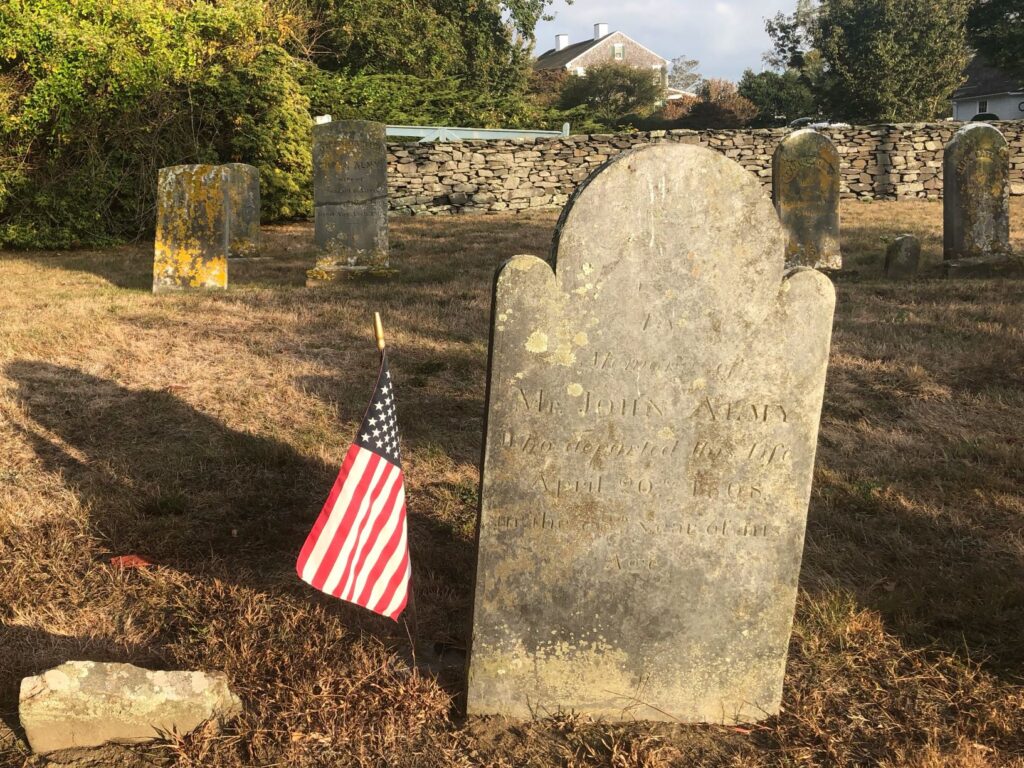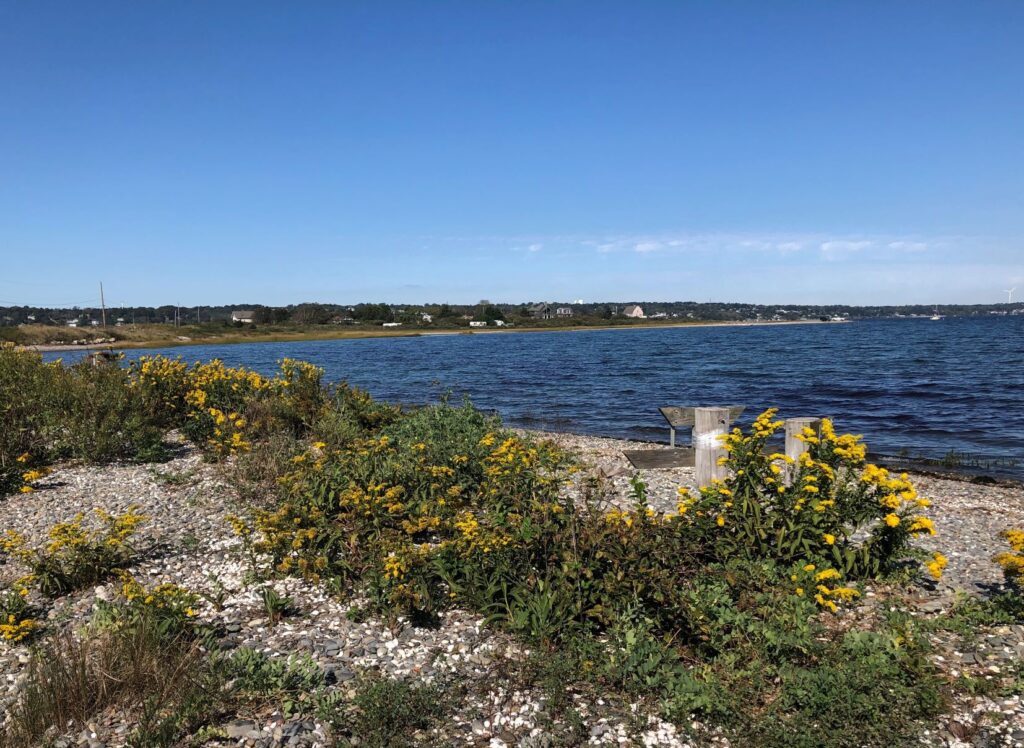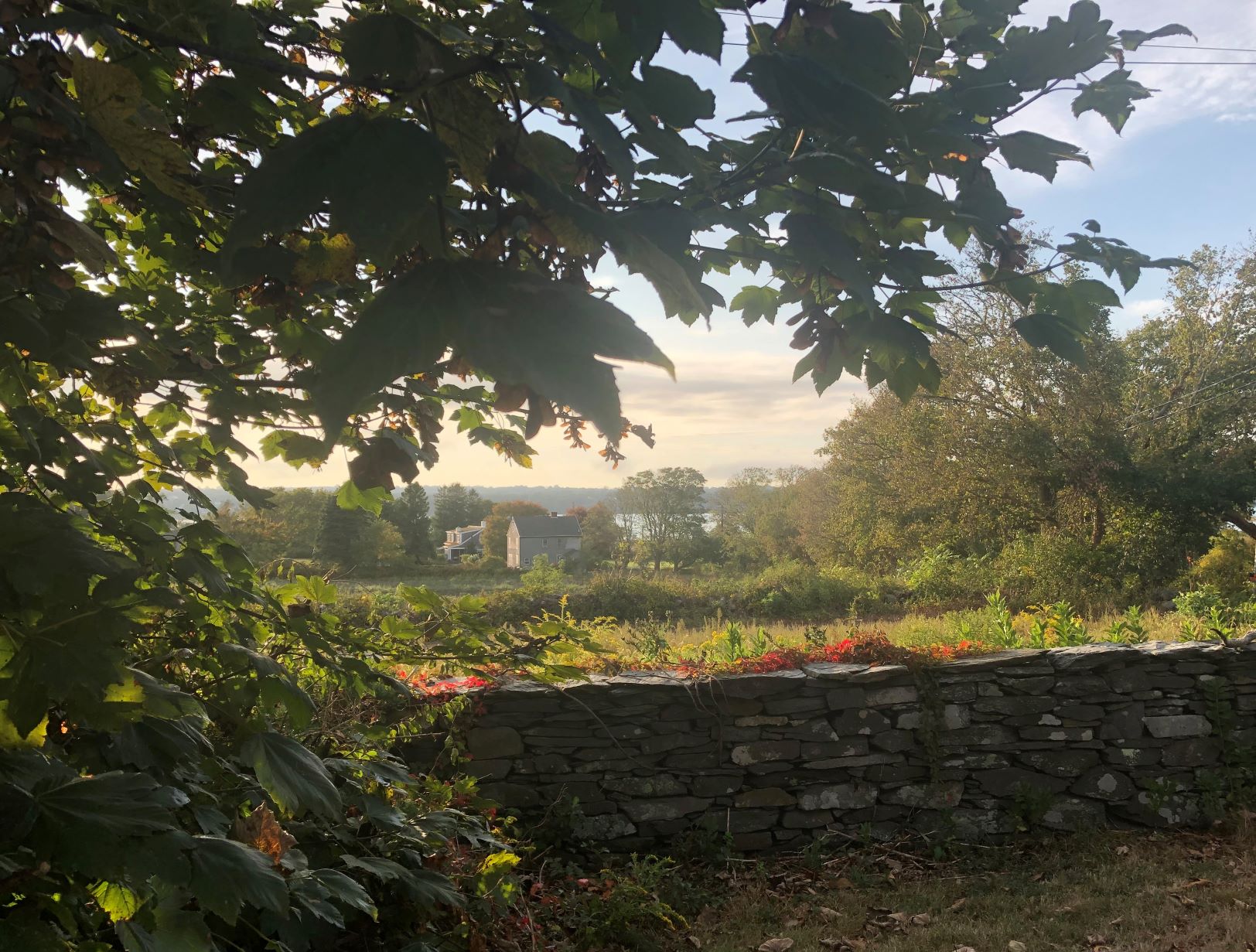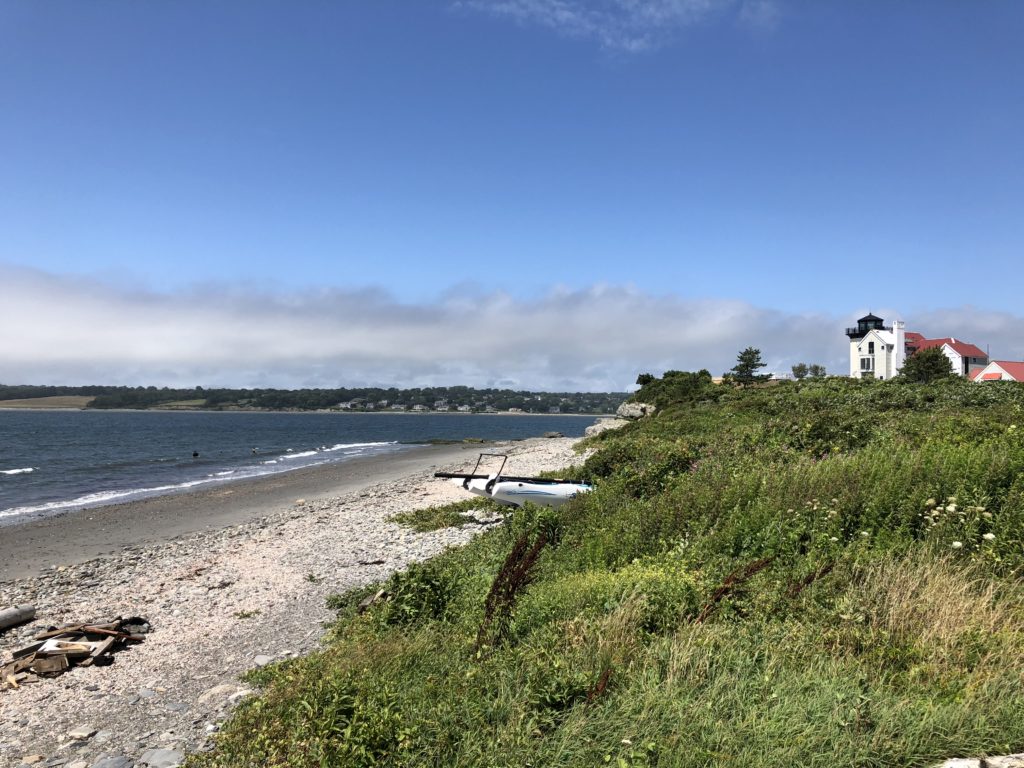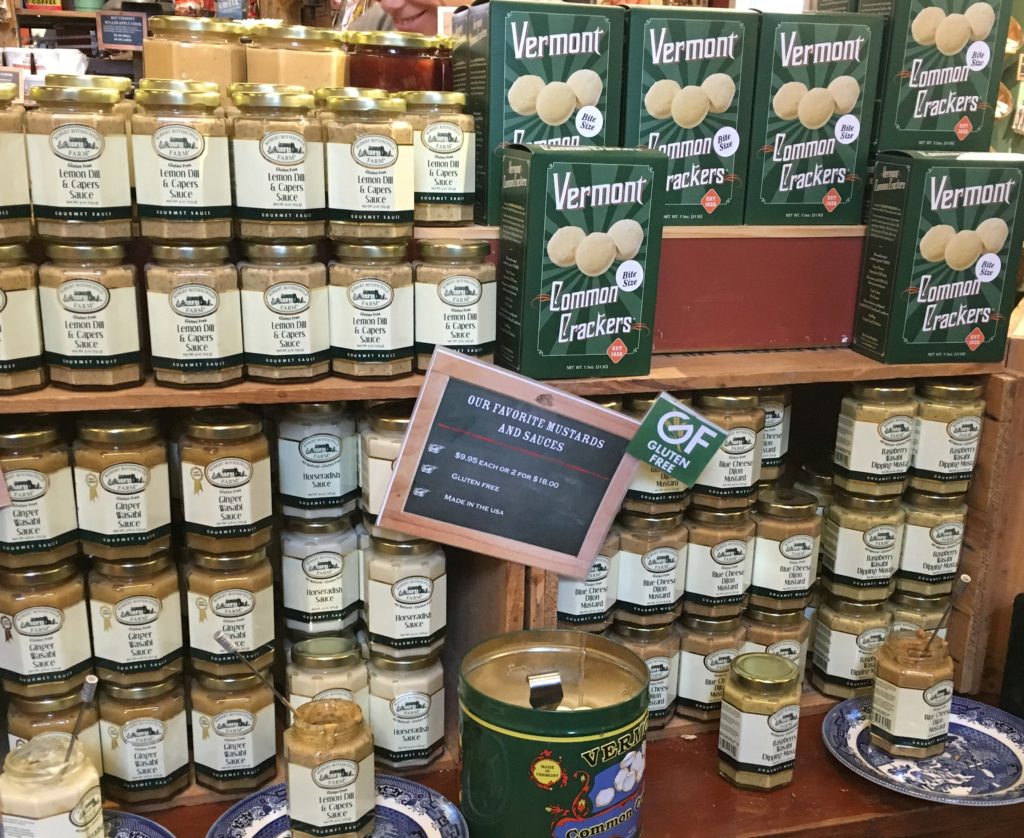On Pond Bridge Road off Main Road in Tiverton, Rhode Island, I drive west toward the Sakonnet River, about a half mile away at the foot of sloping farmland. The road narrows for a two-lane bridge, past the Nonquit Pond “fish ladder” that river herring from the salty ocean “climb” to go around the dam and upstream to spawn in fresh water. This is quiet southeastern Rhode Island, a remote two-township rural and fishing region along Narragansett Bay off the Atlantic Ocean.
For a moment, here along the Fogland slopes drifting to Fogland Point, I think I’m in late 17th to 18th century New England. Tiverton (the village is several miles north) was incorporated as a township in 1694 and brought into the rest of Rhode Island in 1746. In the 1800s it was the site of grist mills, textile manufacturing, whaling and commercial fishing. New Bedford, MA to the east, just before the bridge to Cape Cod, was the center of the whaling industry for the East Coast between 1835 and 1859, until kerosene came into common use. (Today the New Bedford Whaling Museum is one of the most fascinating stops in the region, easily a half-day experience, with exhibits including the culture of whaling, the world’s largest collection of scrimshaw, fine and contemporary arts, a discovery center and, special exhibitions of great variety. On a later visit, I learned about the central importance of the extensive maritime dimensions of the Underground Railroad in a deeply researched exhibit called Sailing to Freedom.)
Tiverton-posted ships were part of the Rhode Island whaling fleet.
This settlement of farms and residences and vestiges of fishing ports actually dates back to the Plymouth Colony and Rhode Island’s Native American history, home of the Wampanoag, the main tribe from the Narragansett Bay to Cape Cod. Several “Almy” family houses from the mid-to-late 1700s remain. And, from what I am reading in books on the shelves of this cottage, Jacob Almy operated a ferry from Fogland Point to connect with other parts of the state.
To the left of this property where I’m staying is a large Second Empire (1875) rambling grey shingle “cottage” with a tapered tower, cresting finials and pedimented dormers, which is home to one of the largest existing farms in the region. As a sign of the preservation values here, it belongs to Ferolbink Farms, which operates on 300 acres protected from development by the Tiverton Land Trust and The Nature Conservancy.
Fogland and the Tiverton Region
I approached my rental with nervous anticipation, as if it were my long-awaited dreamshot in Tuscany. I’ve definitely waited long enough – for months, I laboriously put together this visit to New England from the Carolinas to see my family after seven months in forced pandemic seclusion. Tucked behind a wall of flat fieldstones, beside a field a wild asters, goldenrod and milkweed, and with an arbor draped with tentacles of brambles, the humble L-shaped cottage quietly looks over acres of working fields all the way to the ocean to the south. A hulking harvester spits grain into a big truck in one of them.
Across the road is what was once known as Almy’s “peasefield,” the site of the Battle of Fogland or “King Philip’s War” in 1675-76, an early skirmish known among English settlers and Native Americans, whose leader (King Philip) was defeated. The battle was behind the Almy House (1758), which is still sturdy as one of several well-preserved shake-shingle “Almy” houses that predominate Puncatest Neck. The Almy family cemetery is in my front yard, sequestered behind a half wall of shale and sedimentary rock. Among a dozen pocked tombstones covered by crawling fingers of yellow lichens is a Revolutionary soldier’s grave, but the details are too eroded to read.
When I booked the rental for early fall, I was primarily intent on finding a property that was affordable and available where I needed to be, though unaware of the extensive historical connections and other payoffs that I would soon experience.
The cottage hugs the ground, shielded by rangy bushes and a dense holly tree. A flaking white trellis with a thick woody vine curling across the top frames the front door. Below are two nearly spent pots of red-orange impatiens. The salt air and winds have had their way on the exteriors of these residences over the years. An open screen door leads into a kitchen with a red brick linoleum floor. A “vintage” working microwave and a Mr. Coffee machine sit on the counter, and above them are three narrow shelves with mugs, glassware and small ceramic pitchers. To the left is an oak drop-leaf table with three chairs and a glass-front hutch painted with old-world figures. Through the window I see a short clothes line, a small Weber grill and in the distance, the Sakonnet River.
I continue my tour inside. The pine living room walls lead up to a vaulted ceiling of 10-inch-wide reddish boards like the inside of a barn. It’s comfortably rustic, with exposed end posts and rafters and an antique soft pine floor painted grey. (“All high heels, particularly stilettos, should be removed upon entering this house…This is a longstanding family rule…” reads the proprietor’s instructions.)
An unmade twin bed lies at the far end and situated around the spacious rectangular room are a white sofa, small television and antique chest. A few musty books are stacked on the shelves and a couple of photos of an old gentleman in overalls, circa 1800s. A floor or table lamp is in each of the four corners, and two red post-modern upholstered arm chairs are posted as sentries beside the black iron firebox and field stone mantle. There are windows everywhere, several open to the light breeze. Through the folding door to the bedroom, four pillows rest on a mattress cover. I realize there are no blankets or quilt, and though instructed to “bring my own linens” due to COVID-19, I sent only sheets and towels. Hmmm…no insulation in the living room, a non-working fireplace, no heat because it’s a “seasonal” rental…Ooops! I texted my brother, who would be delivering dinner provisions later in the afternoon. “HELP – bring blankets!!”
The final room left behind any misgivings I was harboring. Two walls of French windows framed a bright sun room holding an ample cushioned wicker furniture. In the distance, the patterned fields stretched to the ocean and swallows were darting across the sky. My mind slowed down in the face of the stunning vista, with late-season peppers rising in one nearby plot and harvested butternut squash “curing” for market across a side road. Trucks rumbling back and forth along a side road from field to market animated the scene. Angling sun sharpened the outlines of burgundy hydrangeas. Miles away to the southwest was the tip of Newport Point. In two weeks, the giant maple at the edge of this property would be turning brilliant red.
Immediately I began to imagine the outlines of my 14-day “quarantine” before I could leave isolation and travel to see friends and family in the region. Travel is abundant with unexpected “discovery” – you just have to be brave enough! Rental websites cannot convey is the mood a location creates at any instant and the feelings brought by each visitor. As a solo Womantraveler, I was finally “back on the road,” so to speak, seeking one last stimulating destination before daylight savings ends and we are once again confined for the winter as the virus surges. I was already familiar with the area’s semi-rural setting but not the details that only residents of the region would know. Nor could I anticipate its welcoming spirit and the psychological healing this mini-adventure and timely change of scenery would bring.
Resourcefulness – a Key to Resilience
Thus far, however, one of my major learnings from the pandemic isolation is the value of being resourceful – and finding ways to create rewarding, safe experiences. In many ways, it’s a solo adventure, and making positive things happen results in the personal power of “yes.”
Rhode Island was a perfect choice because of its great diversity, even within the confines of the pandemic. The state has 400 miles of winding coastline and 2300 acres of parks. Tiverton and Little Compton are situated on the eastern peninsula that is attached to southern Massachusetts and also connected to the rest of the Rhode Island by the Sakonnet River Bridge. From certain rocky coastal beaches, you can look west across Narragansett Bay toward Newport and to the east to Martha’s Vineyard. Several years ago my brother chose this area to renovate and open the Red Dory Restaurant, leaving his previous restaurant in Cambridge, MA (Rendezvous Central Square) for this beautiful area reminiscent of the Chesapeake Bay and Tidewater Virginia, near where we spent our younger years. There’s a feeling of freedom here, with long and wide vistas across farms and abundant birds – warblers, orioles, owls and red-tailed hawks. Despite the pandemic isolation, I felt the visual comfort of the familiar and more easily settled into my temporary “home.”
